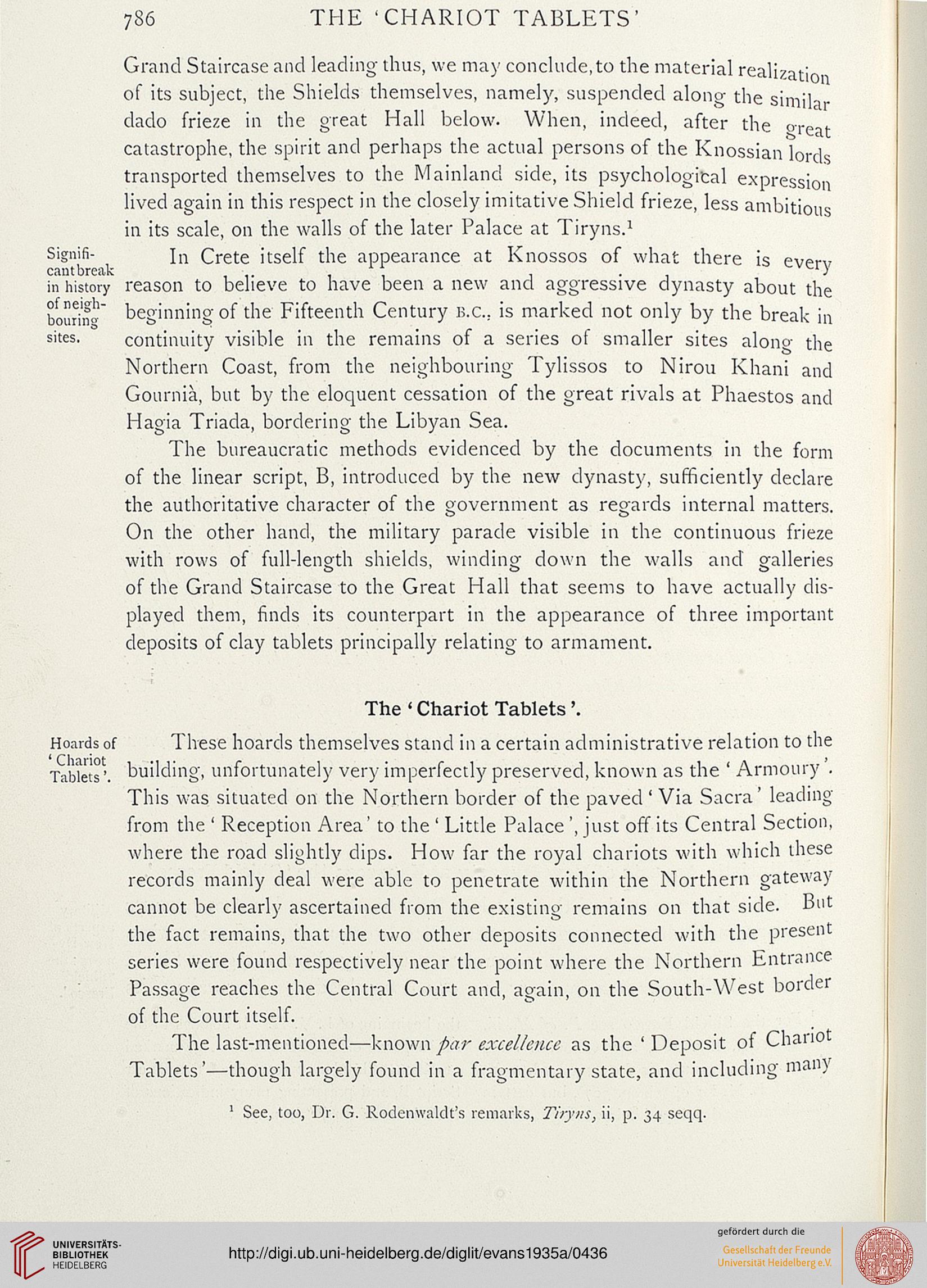786 THE 'CHARIOT TABLETS'
Grand Staircase and leading thus, we may conclude,to the material realizatio
of its subject, the Shields themselves, namely, suspended along the simila •
dado frieze in the great Hall below. When, indeed, after the great
catastrophe, the spirit and perhaps the actual persons of the Knossian lords
transported themselves to the Mainland side, its psychological expression
lived again in this respect in the closely imitative Shield frieze, less ambitious
in its scale, on the walls of the later Palace at Tiryns.1
Signifi- ln Crete itself the appearance at Knossos of what there is ever,,
CJlIltbrCilK .*-/
in history reason to believe to have been a new and aggressive dynasty about the
bourirS" beginning of the Fifteenth Century B.C., is marked not only by the break in
sites- continuity visible in the remains of a series of smaller sites along the
Northern Coast, from the neighbouring Tylissos to Nirou Khani and
Gournia, but by the eloquent cessation of the great rivals at Phaestos and
Hagia Triada, bordering the Libyan Sea.
The bureaucratic methods evidenced by the documents in the form
of the linear script, B, introduced by the new dynasty, sufficiently declare
the authoritative character of the government as regards internal matters.
On the other hand, the military parade visible in the continuous frieze
with rows of full-length shields, winding down the walls and galleries
of the Grand Staircase to the Great Hall that seems to have actually dis-
played them, finds its counterpart in the appearance of three important
deposits of clay tablets principally relating to armament.
The ' Chariot Tablets '.
Hoards of These hoards themselves stand in a certain administrative relation to the
Tablets'. building, unfortunately very imperfectly preserved, known as the ' Armoury .
This was situated on the Northern border of the paved ' Via Sacra' leading
from the ' Reception Area' to the ' Little Palace ', just off its Central Section,
where the road slightly dips. How far the royal chariots with which these
records mainly deal were able to penetrate within the Northern gateway
cannot be clearly ascertained from the existing remains on that side. But
the fact remains, that the two other deposits connected with the present
series were found respectively near the point where the Northern Entrance
Passage reaches the Central Court and, again, on the South-West border
of the Court itself.
The last-mentioned—known par excellence as the 'Deposit of Chariot
Tablets'—though largely found in a fragmentary state, and including man)
1 See, too, Dr. G. Rodenwaldt's remarks, Tiryns, ii, p. 34 seqq.
Grand Staircase and leading thus, we may conclude,to the material realizatio
of its subject, the Shields themselves, namely, suspended along the simila •
dado frieze in the great Hall below. When, indeed, after the great
catastrophe, the spirit and perhaps the actual persons of the Knossian lords
transported themselves to the Mainland side, its psychological expression
lived again in this respect in the closely imitative Shield frieze, less ambitious
in its scale, on the walls of the later Palace at Tiryns.1
Signifi- ln Crete itself the appearance at Knossos of what there is ever,,
CJlIltbrCilK .*-/
in history reason to believe to have been a new and aggressive dynasty about the
bourirS" beginning of the Fifteenth Century B.C., is marked not only by the break in
sites- continuity visible in the remains of a series of smaller sites along the
Northern Coast, from the neighbouring Tylissos to Nirou Khani and
Gournia, but by the eloquent cessation of the great rivals at Phaestos and
Hagia Triada, bordering the Libyan Sea.
The bureaucratic methods evidenced by the documents in the form
of the linear script, B, introduced by the new dynasty, sufficiently declare
the authoritative character of the government as regards internal matters.
On the other hand, the military parade visible in the continuous frieze
with rows of full-length shields, winding down the walls and galleries
of the Grand Staircase to the Great Hall that seems to have actually dis-
played them, finds its counterpart in the appearance of three important
deposits of clay tablets principally relating to armament.
The ' Chariot Tablets '.
Hoards of These hoards themselves stand in a certain administrative relation to the
Tablets'. building, unfortunately very imperfectly preserved, known as the ' Armoury .
This was situated on the Northern border of the paved ' Via Sacra' leading
from the ' Reception Area' to the ' Little Palace ', just off its Central Section,
where the road slightly dips. How far the royal chariots with which these
records mainly deal were able to penetrate within the Northern gateway
cannot be clearly ascertained from the existing remains on that side. But
the fact remains, that the two other deposits connected with the present
series were found respectively near the point where the Northern Entrance
Passage reaches the Central Court and, again, on the South-West border
of the Court itself.
The last-mentioned—known par excellence as the 'Deposit of Chariot
Tablets'—though largely found in a fragmentary state, and including man)
1 See, too, Dr. G. Rodenwaldt's remarks, Tiryns, ii, p. 34 seqq.




